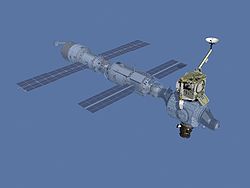
STS-92
Encyclopedia
STS-92 was a Space Shuttle
mission to the International Space Station
(ISS) flown by Space Shuttle Discovery
. STS-92 marked the 100th mission of the Space Shuttle. It was launched from Kennedy Space Center
, Florida, 11 October 2000.
 STS-92 was an ISS assembly flight that brought the Z1 truss, Control Moment Gyros, Pressurized Mating Adapter
STS-92 was an ISS assembly flight that brought the Z1 truss, Control Moment Gyros, Pressurized Mating Adapter
-3 (PMA-3) (mounted on a Spacelab pallet) and two DDCU (Heat pipes) to the space station.
ITS Z1 is an early exterior framework to allow the first U.S. solar arrays on flight 4A to be temporarily installed on Unity for early power. The Ku-band communication system supports early science capability and U.S. television on 6A. The CMGs (Control Moment Gyros) weigh about 27 kilograms (59.5 lb) and provide non-propulsive (electrically powered) attitude control when activated on 5A, and PMA-3 provides shuttle docking port for solar array installation on 4A, Lab installation on 5A.
The mission included seven days of docked operations with the space station, four EVAs, and two ingress opportunities.
Over the course of four scheduled spacewalks, two teams of space walkers and an experienced robot arm operator collaborated to install the Z1 (Z for zenith port) truss structure on top of the U.S. Unity connecting node on the growing station and to deliver the third Pressurized Mating Adapter (PMA 3) to the ISS for the future berthing of new station components and to accommodate shuttle dockings.
The Z1 truss was the first permanent lattice-work structure for the ISS, very much like a girder, setting the stage for the future addition of the station's major trusses or backbones. The Z1 fixture also served as the platform on which the huge U.S. solar arrays were mounted on the next shuttle assembly flight, STS-97
.
The Z1 contains four large gyroscopic devices, called Control Moment Gyroscope
(CMGs), which are used to maneuver the space station into the proper orientation on orbit once they were activated following the installation of the U.S. laboratory.
During the fourth spacewalk, astronauts Wisoff and Lopez-Alegria tested the SAFER
jet backpack
, flying up to 50 feet from the spacecraft.
File:STS-92 launch.ogv
File:STS-92 landing.ogv
Space Shuttle
The Space Shuttle was a manned orbital rocket and spacecraft system operated by NASA on 135 missions from 1981 to 2011. The system combined rocket launch, orbital spacecraft, and re-entry spaceplane with modular add-ons...
mission to the International Space Station
International Space Station
The International Space Station is a habitable, artificial satellite in low Earth orbit. The ISS follows the Salyut, Almaz, Cosmos, Skylab, and Mir space stations, as the 11th space station launched, not including the Genesis I and II prototypes...
(ISS) flown by Space Shuttle Discovery
Space Shuttle Discovery
Space Shuttle Discovery is one of the retired orbiters of the Space Shuttle program of NASA, the space agency of the United States, and was operational from its maiden flight, STS-41-D on August 30, 1984, until its final landing during STS-133 on March 9, 2011...
. STS-92 marked the 100th mission of the Space Shuttle. It was launched from Kennedy Space Center
Kennedy Space Center
The John F. Kennedy Space Center is the NASA installation that has been the launch site for every United States human space flight since 1968. Although such flights are currently on hiatus, KSC continues to manage and operate unmanned rocket launch facilities for America's civilian space program...
, Florida, 11 October 2000.
Crew
Mission parameters
- MassMassMass can be defined as a quantitive measure of the resistance an object has to change in its velocity.In physics, mass commonly refers to any of the following three properties of matter, which have been shown experimentally to be equivalent:...
:- Orbiter Liftoff: 115127 kilograms (253,811.6 lb)
- Orbiter Landing: 92741 kilograms (204,458.9 lb)
- Payload: 9513 kilograms (20,972.6 lb)
- PerigeePerigeePerigee is the point at which an object makes its closest approach to the Earth.. Often the term is used in a broader sense to define the point in an orbit where the orbiting body is closest to the body it orbits. The opposite is the apogee, the farthest or highest point.The Greek prefix "peri"...
: 386 kilometres (239.8 mi) - Apogee: 394 kilometres (244.8 mi)
- InclinationInclinationInclination in general is the angle between a reference plane and another plane or axis of direction.-Orbits:The inclination is one of the six orbital parameters describing the shape and orientation of a celestial orbit...
: 51.6° - PeriodOrbital periodThe orbital period is the time taken for a given object to make one complete orbit about another object.When mentioned without further qualification in astronomy this refers to the sidereal period of an astronomical object, which is calculated with respect to the stars.There are several kinds of...
: 92.3 min
Space walks
- Chiao and McArthur – EVA 1
- EVA 1 Start: 15 October 2000 – 14:27 UTC
- EVA 1 End: 15 October 2000 – 20:55 UTC
- Duration: 6 hours, 28 minutes
- Lopez-Alegria and Wisoff – EVA 2
- EVA 2 Start: 16 October 2000 – 14:15 UTC
- EVA 2 End: 16 October 2000 – 21:22 UTC
- Duration: 7 hours, 07 minutes
- Chiao and McArthur – EVA 3
- EVA 3 Start: 17 October 2000 – 14:30 UTC
- EVA 3 End: 17 October 2000 – 21:18 UTC
- Duration: 6 hours, 48 minutes
- Lopez-Alegria and Wisoff – EVA 4
- EVA 4 Start: 18 October 2000 – 15:00 UTC
- EVA 4 End: 18 October 2000 – 21:56 UTC
- Duration: 6 hours, 56 minutes
Mission highlights

Pressurized Mating Adapter
The International Space Station uses three Pressurized Mating Adapters to interconnect spacecraft and modules with different docking mechanisms. The first two PMAs were launched with the Unity module in 1998 aboard STS-88...
-3 (PMA-3) (mounted on a Spacelab pallet) and two DDCU (Heat pipes) to the space station.
ITS Z1 is an early exterior framework to allow the first U.S. solar arrays on flight 4A to be temporarily installed on Unity for early power. The Ku-band communication system supports early science capability and U.S. television on 6A. The CMGs (Control Moment Gyros) weigh about 27 kilograms (59.5 lb) and provide non-propulsive (electrically powered) attitude control when activated on 5A, and PMA-3 provides shuttle docking port for solar array installation on 4A, Lab installation on 5A.
The mission included seven days of docked operations with the space station, four EVAs, and two ingress opportunities.
Over the course of four scheduled spacewalks, two teams of space walkers and an experienced robot arm operator collaborated to install the Z1 (Z for zenith port) truss structure on top of the U.S. Unity connecting node on the growing station and to deliver the third Pressurized Mating Adapter (PMA 3) to the ISS for the future berthing of new station components and to accommodate shuttle dockings.
The Z1 truss was the first permanent lattice-work structure for the ISS, very much like a girder, setting the stage for the future addition of the station's major trusses or backbones. The Z1 fixture also served as the platform on which the huge U.S. solar arrays were mounted on the next shuttle assembly flight, STS-97
STS-97
STS-97 was a Space Shuttle mission to the International Space Station flown by Space Shuttle Endeavour. The crew installed the first set of solar arrays to the ISS, prepared a docking port for arrival of the Destiny Laboratory Module, and delivered supplies for the station's crew.-Crew:-Mission...
.
The Z1 contains four large gyroscopic devices, called Control Moment Gyroscope
Control moment gyroscope
A control momentum gyroscope is an attitude control device generally used in spacecraft attitude control systems. A CMG consists of a spinning rotor and one or more motorized gimbals that tilt the rotor’s angular momentum. As the rotor tilts, the changing angular momentum causes a gyroscopic...
(CMGs), which are used to maneuver the space station into the proper orientation on orbit once they were activated following the installation of the U.S. laboratory.
During the fourth spacewalk, astronauts Wisoff and Lopez-Alegria tested the SAFER
Simplified Aid for EVA Rescue
Simplified Aid for EVA Rescue is a small, self-contained, propulsive backpack system used to provide free-flying mobility for a Space Shuttle or International Space Station crewmember during extra-vehicular activity...
jet backpack
Jet pack
Jet pack, rocket belt, rocket pack, and similar names are various types of devices, usually worn on the back, that are propelled by jets of escaping gases so as to allow a single user to fly....
, flying up to 50 feet from the spacecraft.
Media
File:STS-92 launch.ogv
File:STS-92 landing.ogv
See also
- Space scienceSpace scienceThe term space science may mean:* The study of issues specifically related to space travel and space exploration, including space medicine.* Science performed in outer space ....
- Space shuttleSpace ShuttleThe Space Shuttle was a manned orbital rocket and spacecraft system operated by NASA on 135 missions from 1981 to 2011. The system combined rocket launch, orbital spacecraft, and re-entry spaceplane with modular add-ons...
- List of space shuttle missions
- List of human spaceflights chronologically
- List of ISS spacewalks
- List of spacewalks

